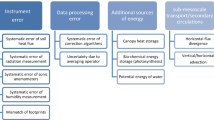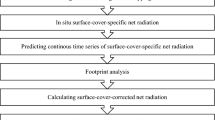Abstract
Single-tower eddy-covariance measurements represent the complete surface flux of a scalar only under idealized conditions. Therefore, we often find an underestimation of energy fluxes expressed as a lack of energy balance closure at many sites. In this study, a multi-tower approach to measure atmospheric energy fluxes based on spatial averaging is evaluated and possible mechanisms causing a lack of energy balance closure are analysed, focussing on daytime data only. It is shown that the multi-tower technique is also unable to measure the entire flux for our site, likely because the assumption of horizontal homogeneity is violated. Heterogeneity-induced and buoyancy-driven quasi-stationary circulations are probably the dominant processes causing the underestimation of energy fluxes. A dependence of the energy balance residual on stability is found, with residuals close to zero for stable stratification, a maximum under unstable to near-neutral conditions and still relatively large residuals for stronger instability. Assuming the processes transporting energy and CO2 are similar, the implications on long-term CO2 flux measurements are analysed. Accordingly, the resulting selective systematic error of cumulative net ecosystem exchange estimates for agricultural regions such as ours can be of the order of more than 100%, since mainly the fluxes during periods of net CO2 uptake are underestimated while periods of net CO2 release are much less affected by this bias. Further investigations about this issue are highly warranted.
Similar content being viewed by others
References
Barr AG, Morgenstern K, Black TA, McCaughey JH, Nesic Z (2006) Surface energy balance closure by the eddy-covariance method above three boreal forest stands and implications for the measurement of the CO2 flux. Agric For Meteorol 140: 322–337
Culf AD, Foken T, Gash JHC (2004) The energy balance closure problem. In: Kabat P, Claussen M (eds) Vegetation, water, humans and the climate. A new perspective on an interactive system. Springer, Berlin, pp 159–166
Desjardins RL (1985) Carbon dioxide budget of maize. Agric For Meteorol 36: 29–41
Falge E, Baldocchi D, Olson R, Anthoni P, Aubinet M, Bernhofer C, Burba G, Ceulemans R, Clement R, Dolman H, Granier A, Gross P, Grunwald T, Hollinger D, Jensen NO, Katul G, Keronen P, Kowalski A, Lai CT, Law BE, Meyers T, Moncrieff H, Moors E, Munger JW, Pilegaard K, Rannik U, Rebmann C, Suyker A, Tenhunen J, Tu K, Verma S, Vesala T, Wilson K, Wofsy S (2001) Gap filling strategies for defensible annual sums of net ecosystem exchange. Agric For Meteorol 107: 43–69
Finnigan J (1999) A comment on the paper by Lee (1998): “on micrometeorological observations of surface-air exchange over tall vegetation”. Agric For Meteorol 97: 55–64
Finnigan JJ, Clement R, Malhi Y, Leuning R, Cleugh HA (2003) A re-evaluation of long-term flux measurement techniques, Part I: averaging and coordinate rotation. Boundary-Layer Meteorol 107: 1–48
Foken T (2008) The energy balance closure problem—an overview. Ecol Appl 18: 1351–1368
Foken T, Oncley SP (1995) Workshop on instrumental and methodical problems of land surface flux measurements. Bull Am Meteorol Soc 76: 1191–1193
Foken T, Wichura B (1996) Tools for quality assessment of surface-based flux measurements. Agric For Meteorol 78: 83–105
Foken T, Wimmer F, Mauder M, Thomas C, Liebethal C (2006) Some aspects of the energy balance closure problem. Atmos Chem Phys 6: 4395–4402
Goulden ML, Munger JW, Fan SM, Daube BC (1996) Measurement of carbon sequestration by long-term eddy covariance: methods and a critical evaluation of accuracy. Glob Change Biol 2: 169–182
Guo X, Zhang H, Cai X, Kang L, Zhu T, Leclerc M (2009) Flux-variance method for latent heat and carbon dioxide fluxes in unstable conditions. Boundary-Layer Meteorol 131: 363–384
Huang J, Lee X, Patton EG (2008) A modelling study of flux imbalance and the influence of entrainment in the convective boundary layer. Boundary-Layer Meteorol 127: 273–292
Inagaki A, Letzel MO, Raasch S, Kanda M (2006) Impact of surface heterogeneity on energy imbalance. J Meteorol Soc Jpn 84: 187–198
Jegede OO, Foken T (1999) A study of the internal boundary layer due to a roughness change in neutral conditions observed during the LINEX field campaigns. Theor Appl Climatol 62: 31–41
Kanda M, Inagaki A, Letzel MO, Raasch S, Watanabe T (2004) LES study of the energy imbalance problem with eddy covariance fluxes. Boundary-Layer Meteorol 110: 381–404
Kohsiek W, Liebethal C, Foken T, Vogt R, Oncley SP, Bernhofer C, DeBruin HAR (2007) The Energy Balance Experiment EBEX-2000. Part III: behaviour and quality of the radiation measurements. Boundary-Layer Meteorol 123: 55–75
Lee X, Black TA (1993) Atmospheric turbulence within and above a Douglas-fir stand. Part II: eddy fluxes of sensible heat and water vapour. Boundary-Layer Meteorol 64: 369–389
Liebethal C, Huwe B, Foken T (2005) Sensitivity analysis for two ground heat flux calculation approaches. Agric For Meteorol 132: 253–262
Mauder M, Foken T (2006) Impact of post-field data processing on eddy covariance flux estimates and energy balance closure. Meteorol Z 15: 597–609
Mauder M, Liebethal C, Göckede M, Leps JP, Beyrich F, Foken T (2006) Processing and quality control of flux data during LITFASS-2003. Boundary-Layer Meteorol 121: 67–88
Mauder M, Desjardins RL, MacPherson JI (2007a) Scale analysis of airborne flux measurements over heterogeneous terrain in a boreal ecosystem. J Geophys Res 112: D13112. doi:10.1029/2006JD008133
Mauder M, Jegede OO, Okogbue EC, Wimmer F, Foken T (2007b) Surface energy balance measurements at a tropical site in West Africa during the transition from dry to wet season. Theor Appl Climatol 89: 171–183
Mauder M, Oncley SP, Vogt R, Weidinger T, Ribeiro L, Bernhofer C, Foken T, Kohsiek W, de Bruin HAR, Liu H (2007c) The Energy Balance Experiment EBEX-2000. Part II: intercomparison of eddy-covariance sensors and post-field data processing methods. Boundary-Layer Meteorol 123: 29–54
Mauder M, Desjardins RL, Gao Z, van Haarlem R (2008a) Errors of naturally ventilated air temperature measurements in a spatial observation network. J Atmos Oceanic Technol 25: 2145–2151
Mauder M, Desjardins RL, Pattey E, Gao Z, van Haarlem R (2008b) Measurement of the sensible eddy heat flux based on spatial averaging of continuous ground-based observations. Boundary-Layer Meteorol 128: 151–172
Oncley SP, Foken T, Vogt R, Kohsiek W, De Bruin H, Bernhofer C, Christen A, Grantz D, Lehner E, Liebethal C, Liu H, Mauder M, Pitacco A, Ribeiro L, Weidinger T (2007) The Energy Balance Experiment EBEX-2000. Part I: overview and energy balance. Boundary-Layer Meteorol 123: 1–28
Pattey E, Strachan IB, Boisvert JB, Desjardins RL, McLaughlin NB (2001) Detecting effects of nitrogen rate and weather on corn groth using micrometeorological and hyperspectral reflectance measurements. Agric For Meteorol 108: 85–99
Pattey E, Strachan IB, Desjardins RL, Massheder JM (2002) Measuring nighttime CO2 flux over terrestrial ecosystems using eddy covariance and nocturnal boundary layer methods. Agric For Meteorol 113: 145–158
Pattey E, Edwards GC, Strachan IB, Desjardins RL, Kaharabata SK, Wagner-Riddle C (2006) Towards standards for measuring greenhouse gas flux agricultural fields using instrumented towers. Can J Soil Sci 86: 373–400
Poggi D, Katul GG, Albertson JD (2004) A note on the contribution of dispersive fluxes to momentum transfer within canopies. Boundary-Layer Meteorol 111: 615–621
Ruppert J, Thomas C, Foken T (2006) Scalar similarity for relaxed eddy accumulation methods. Boundary-Layer Meteorol 120: 39–63
Sakai RK, Fitzjarrald DR, Moore KE (2001) Importance of low-frequency contributions to eddy fluxes observed over rough surfaces. J Appl Meteorol 40: 2178–2192
Scanlon TM, Albertson JD (2001) Turbulent transport of carbon dioxide and water vapor within a vegetation canopy during unstable conditions: identification of episodes using wavelet analysis. J Geophys Res 106: 7251–7262
Schmid HP, Su HB, Vogel CS, Curtis PS (2003) Ecosystem–atmosphere exchange of carbon dioxide over a mixed hardwood forest in northern lower Michigan. J Geophys Res 108. doi:10.1029/2002JD003011
Steinfeld G, Letzel MO, Raasch S, Kanda M, Inagaki A (2007) Spatial representativeness of single tower measurements on the imbalance problem with eddy-covariance fluxes: results of a large-eddy simulation study. Boundary-Layer Meteorol 123: 77–98
Stoy PC, Katul GG, Siqueira MBS, Juang JY, Novick KA, McCarthy HR, Christopher Oishi A, Uebelherr JM, Kim HS, Oren R (2006) Separating the effects of climate and vegetation on evapotranspiration along a successional chronosequence in the southeastern US. Glob Change Biol 12: 2115–2135
Twine TE, Kustas WP, Norman JM, Cook DR, Houser PR, Meyers TP, Prueger JH, Starks PJ, Wesely ML (2000) Correcting eddy-covariance flux underestimates over a grassland. Agric For Meteorol 103: 279–300
Wang W (2010) The influence of topography on single-tower-based carbon flux measurements under unstable conditions: a modeling perspective. Theor Appl Climatol 99: 125–138
Webb EK, Pearman GI, Leuning R (1980) Correction of the flux measurements for density effects due to heat and water vapour transfer. Q J Roy Meteorol Soc 106: 85–100
Wilczak JM, Oncley SP, Stage SA (2001) Sonic anemometer tilt correction algorithms. Boundary-Layer Meteorol 99: 127–150
Wilson K, Goldstein A, Falge E, Aubinet M, Baldocchi D, Berbigier P, Bernhofer C, Ceulemans R, Dolman H, Field C (2002) Energy balance closure at FLUXNET sites. Agric For Meteorol 113: 223–243
Author information
Authors and Affiliations
Corresponding author
Rights and permissions
About this article
Cite this article
Mauder, M., Desjardins, R.L., Pattey, E. et al. An Attempt to Close the Daytime Surface Energy Balance Using Spatially-Averaged Flux Measurements. Boundary-Layer Meteorol 136, 175–191 (2010). https://doi.org/10.1007/s10546-010-9497-9
Received:
Accepted:
Published:
Issue Date:
DOI: https://doi.org/10.1007/s10546-010-9497-9




